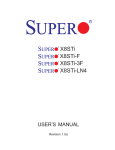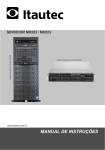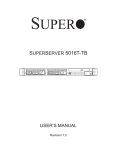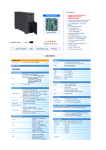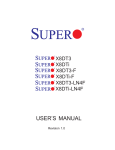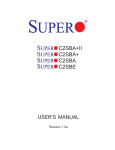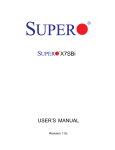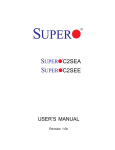Download SUPER MICRO Computer SUPER X8ST3-F User's Manual
Transcript
X8ST3-F
X8STE
USER’S MANUAL
Revision 1.0b
The information in this User’s Manual has been carefully reviewed and is believed to be accurate.
The vendor assumes no responsibility for any inaccuracies that may be contained in this document,
makes no commitment to update or to keep current the information in this manual, or to notify any
person or organization of the updates. Please Note: For the most up-to-date version of this
manual, please see our web site at www.supermicro.com.
Super Micro Computer, Inc. ("Supermicro") reserves the right to make changes to the product
described in this manual at any time and without notice. This product, including software, if any,
and documentation may not, in whole or in part, be copied, photocopied, reproduced, translated or
reduced to any medium or machine without prior written consent.
IN NO EVENT WILL SUPER MICRO COMPUTER, INC. BE LIABLE FOR DIRECT, INDIRECT,
SPECIAL, INCIDENTAL, SPECULATIVE OR CONSEQUENTIAL DAMAGES ARISING FROM THE
USE OR INABILITY TO USE THIS PRODUCT OR DOCUMENTATION, EVEN IF ADVISED OF
THE POSSIBILITY OF SUCH DAMAGES. IN PARTICULAR, SUPER MICRO COMPUTER, INC.
SHALL NOT HAVE LIABILITY FOR ANY HARDWARE, SOFTWARE, OR DATA STORED OR USED
WITH THE PRODUCT, INCLUDING THE COSTS OF REPAIRING, REPLACING, INTEGRATING,
INSTALLING OR RECOVERING SUCH HARDWARE, SOFTWARE, OR DATA.
Any disputes arising between manufacturer and customer shall be governed by the laws of Santa
Clara County in the State of California, USA. The State of California, County of Santa Clara shall
be the exclusive venue for the resolution of any such disputes. Supermicro's total liability for all
claims will not exceed the price paid for the hardware product.
FCC Statement: This equipment has been tested and found to comply with the limits for a Class
A digital device pursuant to Part 15 of the FCC Rules. These limits are designed to provide
reasonable protection against harmful interference when the equipment is operated in a commercial
environment. This equipment generates, uses, and can radiate radio frequency energy and, if not
installed and used in accordance with the manufacturer’s instruction manual, may cause harmful
interference with radio communications. Operation of this equipment in a residential area is likely
to cause harmful interference, in which case you will be required to correct the interference at your
own expense.
California Best Management Practices Regulations for Perchlorate Materials: This Perchlorate
warning applies only to products containing CR (Manganese Dioxide) Lithium coin cells. “Perchlorate
Material-special handling may apply. See www.dtsc.ca.gov/hazardouswaste/perchlorate”. WARNING: Handling of lead solder materials used in this
product may expose you to lead, a chemical known to
the State of California to cause birth defects and other
reproductive harm.
Manual Revision 1.0b
Release Date: March 6, 2009
Unless you request and receive written permission from Super Micro Computer, Inc., you may not
copy any part of this document.
Information in this document is subject to change without notice. Other products and companies
referred to herein are trademarks or registered trademarks of their respective companies or mark
holders.
Copyright © 2009 by Super Micro Computer, Inc.
All rights reserved.
Printed in the United States of America
Preface
Preface
This manual is written for system integrators, PC technicians and
knowledgeable PC users. It provides information for the installation and use of the
X8ST3-F/X8STE motherboard.
About This Motherboard
The
X8ST3-F/X8STE supports the Intel® Core™ i7 processor and future
Nehalem family processors in the LGA 1366 package. These processors support
the Intel QuickPath Interconnect (QPI) technology, providing the next generation
point-to-point system interface that replaces the current Front Side Bus. With the
Intel X58 Express chipset built-in, the X8ST3-F/X8STE offers substantial enhancement in system performance with increased bandwidth and unprecedented scalability, optimized for intense-computing and high-end server platforms. Please refer
to our web site (http://www.supermicro.com/products/) for updates on supported
processors. This product is intended to be professionally installed and serviced by
a technician.
Manual Organization
Chapter 1 describes the features, specifications and performance of the motherboard and provides detailed information about the chipset.
Chapter 2 provides hardware installation instructions. Read this chapter when installing the processor, memory modules and other hardware components into the
system. If you encounter any problems, see Chapter 3, which describes troubleshooting procedures for video, memory and system setup stored in the CMOS.
Chapter 4 includes an introduction to the BIOS and provides detailed information
on running the CMOS Setup utility.
Appendix A provides BIOS Error Beep Codes.
Appendix B lists the Windows OS Installation Instructions.
Appendix C lists Other Software Program Installation Instructions.
iii
X8ST3-F/X8STE User’s Manual
Conventions Used in the Manual:
Special attention should be given to the following symbols for proper installation and
to prevent damage done to the components or injury to yourself:
Danger/Caution: Instructions to be strictly followed to prevent catastrophic
system failure or to avoid bodily injury
Warning: Important information given to ensure proper system installation
or to prevent damage to the components
Note: Additional Information given to differentiate various models or provides information for correct system setup.
iv
Contacting Supermicro
Contacting Supermicro
Headquarters
Address:
Super Micro Computer, Inc.
980 Rock Ave.
San Jose, CA 95131 U.S.A.
Tel:
+1 (408) 503-8000
Fax:
+1 (408) 503-8008
Email:
[email protected] (General Information)
[email protected] (Technical Support)
Web Site:
www.supermicro.com
Europe
Address:
Super Micro Computer B.V.
Het Sterrenbeeld 28, 5215 ML
's-Hertogenbosch, The Netherlands
Tel:
+31 (0) 73-6400390
Fax:
+31 (0) 73-6416525
Email:
[email protected] (General Information)
[email protected] (Technical Support)
[email protected] (Customer Support)
Asia-Pacific
Address:
Super Micro Computer, Inc.
4F, No. 232-1, Liancheng Rd.
Chung-Ho 235, Taipei County
Taiwan, R.O.C.
Tel:
+886-(2) 8226-3990
Fax:
+886-(2) 8226-3991
Web Site:
www.supermicro.com.tw
Technical Support:
Email:
[email protected]
Tel: 886-2-8228-1366, ext.132 or 139
v
X8ST3-F/X8STE User’s Manual
Table of Contents
Preface
About This Motherboard................................................................................................. 3
Manual Organization...................................................................................................... 3
Conventions Used in the Manual:.................................................................................. 4
Contacting Supermicro................................................................................................... 5
Chapter 1 Introduction
1-1
Overview.......................................................................................................... 1-1
Checklist........................................................................................................... 1-1
Motherboard Features...................................................................................... 1-6
1-2
Chipset Overview . .........................................................................................1-11
1-3
PC Health Monitoring..................................................................................... 1-12
Recovery from AC Power Loss...................................................................... 1-12
Onboard Voltage Monitoring ......................................................................... 1-12
Fan Status Monitor with Software.................................................................. 1-12
CPU Overheat LED and Control .................................................................. 1-12
1-4
Power Configuration Settings........................................................................ 1-12
Slow Blinking LED for Suspend-State Indicator............................................ 1-12
BIOS Support for USB Keyboard.................................................................. 1-13
Main Switch Override Mechanism................................................................. 1-13
Wake-On-LAN (WOL).................................................................................... 1-13
1-5
Power Supply................................................................................................. 1-13
1-6
Super I/O........................................................................................................ 1-14
1-7
Overview of the Winbond WPCM450 Controller........................................... 1-14
Chapter 2 Installation
2-1
Static-Sensitive Devices................................................................................... 2-1
Precautions...................................................................................................... 2-1
Unpacking........................................................................................................ 2-1
2-2
Processor and Heatsink Installation................................................................ 2-2
Installing an LGA 1366 Processor................................................................... 2-2
Installing a Passive CPU Heatsink.................................................................. 2-4
Removing the Heatsink.................................................................................... 2-5
2-3
Mounting the Motherboard into the Chassis.................................................... 2-6
2-4
Installing and Removing the Memory Modules................................................ 2-7
Installing & Removing DIMMs.......................................................................... 2-7
2-5
Connectors/IO Ports....................................................................................... 2-10
Back Panel Connectors and IO Ports............................................................ 2-10
vi
Table of Contents
ATX PS/2 Keyboard and PS/2 Mouse Ports..............................................2-11
Universal Serial Bus (USB)....................................................................... 2-12
Ethernet Ports........................................................................................... 2-13
Serial Ports................................................................................................ 2-14
Video Connector........................................................................................ 2-15
Front Control Panel........................................................................................ 2-16
Front Control Panel Pin Definitions............................................................... 2-17
NMI Button................................................................................................ 2-17
HDD LED................................................................................................... 2-18
NIC1/NIC2 LED Indicators........................................................................ 2-18
Overheat (OH)/Fan Fail LED.................................................................... 2-19
Power Fail LED......................................................................................... 2-19
Reset Button ............................................................................................ 2-20
Power Button ........................................................................................... 2-20
2-6
Connecting Cables......................................................................................... 2-21
ATX Main PWR & CPU PWR Connectors . ............................................. 2-21
Fan Headers.............................................................................................. 2-22
Internal Buzzer.......................................................................................... 2-23
Speaker..................................................................................................... 2-23
Overheat/Fan Fail LED............................................................................. 2-24
Chassis Intrusion ..................................................................................... 2-24
Power Supply I2C Connector.................................................................... 2-25
Onboard Power LED................................................................................. 2-25
T-SGPIO 0/1 & 3-SGPIO 0/1 Headers...................................................... 2-26
Alarm Reset............................................................................................... 2-26
Wake-On-LAN........................................................................................... 2-27
I-Button...................................................................................................... 2-27
2-7
Jumper Settings............................................................................................. 2-28
Explanation of Jumpers................................................................................. 2-28
LAN Port Enable/Disable.......................................................................... 2-28
CMOS Clear.............................................................................................. 2-29
Watch Dog Enable/Disable....................................................................... 2-29
SMB to PCI-X/PCI-E Slots Speeds........................................................... 2-30
(BMC) VGA Enable................................................................................... 2-30
USB Wake-Up .......................................................................................... 2-31
SAS Enable/Disable (X8ST3-F Only)........................................................ 2-32
SAS RAID Mode Select (X8ST3-F Only).................................................. 2-32
BMC IPMI Enable (X7ST3-F only)............................................................ 2-33
2-8
Onboard Indicators......................................................................................... 2-34
vii
X8ST3-F/X8STE User’s Manual
LAN 1/LAN 2 LEDs................................................................................... 2-34
IPMI Dedicated LAN LEDs (X8ST3-F Only)............................................. 2-34
SAS Activity LED (X8ST3-F Only)............................................................ 2-35
SAS Heartbeat LED (X8ST3-F Only)........................................................ 2-35
Onboard Power LED ............................................................................................................. 2-36
2-9
Serial ATA and Floppy Drive Connections..................................................... 2-37
SATA Connectors...................................................................................... 2-37
Floppy Connector...................................................................................... 2-38
Chapter 3 Troubleshooting
3-1
Troubleshooting Procedures............................................................................ 3-1
Before Power On............................................................................................. 3-1
No Power......................................................................................................... 3-1
No Video.......................................................................................................... 3-1
Memory Errors ................................................................................................ 3-2
Losing the System’s Setup Configuration........................................................ 3-2
3-2
Technical Support Procedures......................................................................... 3-2
3-3
Frequently Asked Questions............................................................................ 3-3
3-4
Returning Merchandise for Service................................................................. 3-4
Chapter 4 BIOS
4-1
Introduction....................................................................................................... 4-1
Starting BIOS Setup Utility............................................................................... 4-1
How To Change the Configuration Data.......................................................... 4-1
Starting the Setup Utility.................................................................................. 4-2
4-2 Main Setup....................................................................................................... 4-2
4-3 Advanced Setup Configurations...................................................................... 4-4
4-4
Security Settings............................................................................................ 4-23
4-5
Boot Configuration......................................................................................... 4-24
4-6
Exit Options.................................................................................................... 4-25
Appendix A POST Error Beep Codes
Recoverable POST Error Beep Codes.......................................................................A-1
Appendix B Installing the Windows OS
B-1
Installing the Windows OS for Systems with RAID Functions........................B-1
B-2
Installing the Windows OS for Systems without RAID Functions...................B-2
Appendix C Software Installation Instructions
C-1
Installing Drivers...............................................................................................C-1
C-2
Configuring Supero Doctor II...........................................................................C-2
viii
Chapter 1: Introduction
Chapter 1
Introduction
1-1 Overview
Checklist
Congratulations on purchasing your computer motherboard from an acknowledged
leader in the industry. Supermicro boards are designed with the utmost attention to
detail to provide you with the highest standards in quality and performance.
Please check that the following items have all been included with your motherboard.
If anything listed here is damaged or missing, contact your retailer.
The following items are included in the retail box.
•One (1) Supermicro Mainboard
•Six (6) SATA cables (CBL-0044L)
•One (1) floppy drive ribbon cable (CBL-022L)
•One (1) I/O shield (MCP-260-00027-0N)
•One (1) Supermicro CD containing drivers and utilities (CDR-X8-UP)
•One (1) User's/BIOS Manual (MNL-1040)
1-1
X8ST3-F/X8STE User’s Manual
X8ST3-F Image
Note: All graphics shown in this manual were based upon the latest PCB
Revision available at the time of publishing of the manual. The motherboard
you've received may or may not look exactly the same as the graphics
shown in this manual.
1-2
Chapter 1: Introduction
KB/MOUSE
Motherboard Layout
SMBUS_PS1
JPW2
USB 0/1
FAN1
JPW1
DIMM3A
IPMI_LAN
JPUSB1
CPU FAN
DIMM3B
DIMM2A
COM1
DIMM2B
LAN CTRL
for IPMIl LAN
DIMM1A
DIMM1B
JLED
VGA
LAN
CTRL1
LE1
North Bridge
1
LAN2
JF1
LAN1
Intel X58-Express
Intel Processor
JOH
JWD
JD1
FAN2
Battery
LAN
CTRL2
SPKR1
X8ST3-F/X8STE
Slot5 PCI-E 2.0 X8
Intel ICH10R
South Bridge
BMC
Firmware
JPG1
SAS CTRL
BMC CTRL
LSI 1068E
WPCM 450
3-SGPIO1
BMC JTAG
LES2
SAS6
SAS5
SAS1
SAS4
JPS2
SAS7
USB3
3-SGPIO2
SAS3
JI2C2
USB2
SAS2
JPUSB3
JI2C1
SAS0
Slot1 PCI 33MHz
Floppy
JPUSB2
JL1
JPS1
LES1 FAN3
1
JBMC1
COM2
USB 4/5
SI/O
Slot3 PCI-E 2.0 X8
Slot2 PCI 33MHz
I-SATA0
USB 6/7
Slot4 PCI-E 2.0 X4 on X8
JPL1
JPL2
I-SATA5
I-Button
I-SATA2
BIOS
JWOL
I-SATA4
JBT1
Slot6 PCI-E 2.0 X8 on X16
T-SGPIO1
T-SGPIO2
I-SATA3
I-SATA1
JAR
FAN5
1
FAN4
Important Notes to the User
•Jumpers not indicated are for testing only.
•See Chapter 2 for detailed information on jumpers, I/O ports and JF1 front
panel connections.
•"
" indicates the location of "Pin 1".
•When LE1 (Onboard Power LED Indicator) is on, system power is on. Unplug
the power cable before installing or removing any components.
1-3
X8ST3-F/X8STE User’s Manual
X8ST3-F/X8STE Quick Reference
KB/MOUSE
62
USB 0/1
3
59
SMBUS_PS1
JPW2
FAN1
JPW1
DIMM3A
CPU FAN
DIMM3B
58
DIMM2A
DIMM2B
COM1
2
JPUSB1
60
IPMI_LAN
1
61
LAN CTRL
for IPMIl LAN
DIMM1A
DIMM1B
LAN
CTRL1
JLED
VGA
4
JF1
LAN1
55
1
6
North Bridge
Intel Processor
LAN2
5
57
56 LE1
Intel X58-Express
JOH
SPKR1
I-SATA0
USB 6/7
10
JPG1
LSI 1068E
BMC JTAG
SAS1
JPS2
11
USB3
12
16
1
29
JPUSB2
JL1
35JPS1
LES1 FAN3
32
26
17
18
20 21 22 23
39
38
37
36
34
SAS7
JI2C2
USB2
24
25
SAS3
JI2C1
JPUSB3
3-SGPIO2
1
Floppy
14 15
SAS2
Slot1 PCI 33MHz
19
SAS0
JBMC1
LES2
SAS6
3-SGPIO1
SAS5
WPCM 450
13
USB 4/5
SAS CTRL
BMC CTRL
Slot2 PCI 33MHz
COM2
40
Slot3 PCI-E 2.0 X8
SI/O
9
41
47
BMC
Firmware
Slot4 PCI-E 2.0 X4 on X8
JPL1
JPL2
SAS4
8
I-SATA2
South Bridge
I-Button
49
I-SATA4
BIOS
Slot5 PCI-E 2.0 X8
Intel ICH10R
T-SGPIO1
T-SGPIO2
I-SATA3
I-SATA1
43
JWOL
42
I-SATA5
48
JBT1
Slot6 PCI-E 2.0 X8 on X16
51
50
JAR
44
FAN5
X8ST3-F/X8STE
7
FAN2
46
JD1
45
Battery
LAN
CTRL2
54
53
52
JWD
FAN4
27 28 30 31
33
X8ST3-F/X8STE Jumpers
Jumper
Label
Description
Default Setting
JBMC1
JBT1
#13
BMC Enable
Pins 1-2 (Enabled)
#44
CMOS Clear
(See Chpt. 2)
JI2C1/JI2C2
#14, 15
SMB to PCI Slots
(See Chpt. 2)
JPG1
#10
VGA Enable
Pins 1-2 (Enabled)
JPL1/JPL2
#8, 9
LAN 1/2 Enable
Pins 1-2 (Enabled)
JPS1
#35
SAS Enable (X8ST3-F)
Pins 1-2 (Enabled)
JPS2
#26
SAS RAID Mode (X8ST3-F)
On (Software RAID)
JPUSB1
#62
BP USB0/1 Wake-up
Pins 1-2 (Enabled)
JPUSB2
#37
FP USB 4/5, 6/7 Wake-up
Pins 1-2 (Enabled)
1-4
Chapter 1: Introduction
X8ST3-F/X8STE Jumpers
JPUSB3
#19
FP USB 2, 3 Wake-up
Pins 1-2 (Enabled)
JWD
#53
Watch Dog Timer Enable
Pins 1-2 (Reset)
X8ST3-F/X8STE Headers/Connectors
Connector
Label
Description
Battery
#45
Onboard battery (B1)
COM1/COM2
#3, 11
COM1/2 Serial connection headers
Fans 1~5
#58, 52, 34, 33, 7
System/CPU fan headers (Fan 1: CPU fan)
Floppy
#12
Floppy Disk Drive connector
I-Button
#42
I-Button for RAID data storage
JAR
#50
Alarm Reset
JD1
#51
Speaker header (Pins 3/4: Internal, 1~4:External)
JF1
#55
Front Panel Control header
JL1
#36
Chassis Intrusion header
JLED
#57
Power LED Indicator header
JOH
#54
Overheat LED header
JPW1
#59
24-pin ATX main power connector (required)
JPW2
#61
+12V 8-pin CPU power connector (required)
JWOL
#43
Wake-On-LAN header
KB/Mouse
#1
Keyboard/mouse connectors
LAN1/LAN2
#5, 6
Gigabit Ethernet (RJ45) ports
(IPMI) LAN
#2
IPMI Dedicated LAN (X8ST3-F only)
I-SATA 0~5
#40, 41, 49
Serial_ATA ports
SAS 0~3, 4~7
#20~23, 27, 28,
Serial Attached SCSI Ports (X8ST3-F only)
30, 31
SMB_PS1
#60
PWR supply (I2C) System Management Bus
SPKR1
#46
Internal speaker/buzzer
3-SGPIO-0/1
#24, 25
Serial_link IO headers for SAS (X8ST3-F)
T-SGPIO-0/1
#48, 47
Serial General Purpose IO headers (for SATA)
USB 0~1
#2
(Backpanel) Universal Serial Bus (USB) ports
USB 2, USB 3,
#17, 18, 38, 39
Front panel accessible USB headers
#4
Video Port
USB4/5, 6/7
VGA
X8ST3-F/X8STE LED Indicators
LED
Label
Description
LE1
#56
Onboard Standby PWR warning LED Indicator
LES1
#32
SAS Activity (Blinking: SAS Active) (X8ST3-F only)
LES2
#29
SAS Heartbeat (Blinking: SAS Normal) (X8ST3-F only)
1-5
X8ST3-F/X8STE User’s Manual
Motherboard Features
CPU
• Single
Intel® Core™ i7 and future Nehalem processors in the LGA1366
socket
Memory
• Six 240-pin, DDR3 SDRAM DIMM sockets with support for unbuffered ECC or
non ECC 1333/1066/800 MHz memory.
Note: Both Unbuffered ECC and Non-ECC DIMM modules are supported
by the motherboard. Using ECC or Non-ECC memory on your motherboard
depends on the CPU installed.
• Supports 3-channel memory bus
• DIMM sizes of 256 MB, 512 MB, 1 GB, 2 GB, and 4 GB are supported
Chipset
• Intel® X58 Express Chipset (IOH)
• Intel ICH10R (South Bridge)
Expansion Slots
• One (1) PCI-Express x8 Gen2 on x16 slot (Slot 6)
• Two (2) PCI-Express x8 Gen2 slots (Slot 3/Slot 5)
• One PCI-Express x4 on x8 slot (Slot 4)
• Two (2) 32-bit PCI 33MHz slots (Slot 1/Slot 2)
Graphics
• Support for multiple PCI-Express Graphics cards (Gen 2 or Gen 1)
• Matrox G200 with 16 MB DDR2 Memory
Network Connections
• Intel Dual-channel 82574L Gigabit (10/100/1000 Mb/s) Ethernet Controller with
two Gigabit LAN ports (LAN 1 and LAN 2)
• Realtek RTL8201N PHY (Dedicated LAN for X8ST3-F)
• Three (3) RJ-45 backplane connectors with Link and Activity LEDs built-in
I/O Devices
SATA Connections
• Six (6) SATA ports supported by the Intel ICH10R SATA Controller
• Supports RAID 0, 1, 5, 10 under the Windows OS environment
• Supports RAID 0, 1 , 10 under the Linux OS environment
1-6
Chapter 1: Introduction
SAS Connections (for the X8ST3-F only)
• Eight (8) SAS ports supported by the LSI 1068E Controller
• Supports RAID 0, 1, 5*, 10 under the Windows OS environment
• Supports RAID 0, 1 , 5*, 10 under the Linux OS environment
Notes:
1. RAID 5 is supported when the I-Button (AOC-IButton68) is installed on
the motherboard. For more information on the AOC-IButton68, please refer
to http://www.supermicro.com/products/accessories/addon/AOC-IButton68.
cfm.
2. For the LSI 1068 Controller User's Guide, please refer to http://www.
supermicro.com/support/manuals/.
Integrated IPMI 2.0 (for the X8ST3-F only)
• IPMI 2.0 supported by the WPCM450 Server BMC
Note: For IPMI Configuration Instructions, please refer to the Embedded
IPMI Configuration User's Guide available @ http://www.supermicro.com/
support/manuals/.
Floppy Drive
• One (1) floppy port interface (up to 1.44 MB)
USB Devices
• Two (2) USB ports (USB 0~1) on the IO backplane for rear access
• Six (6) USB connections for front access (Two Type A connectors: USB 2,
USB 3 and two headers: USB 4/5, 6/7)
Keyboard/Mouse
• PS/2 Keyboard/Mouse ports on the I/O backplane
Serial (COM) Ports
• Fast UART 16550 Connections: one COM port and one header
Super I/O
• Winbond Super I/O 83627DHG
BIOS
• 4 MB SPI AMI BIOS® SM Flash BIOS
• DMI 2.3, PCI 2.3, ACPI 1.0/2.0/3.0, USB Keyboard and SMBIOS 2.5
Power Configuration
• ACPI/ACPM Power Management
• Main switch override mechanism
1-7
X8ST3-F/X8STE User’s Manual
• Keyboard Wake-up from Soft-Off
• USB Wake-up from Soft-Off
• Wake-on-LAN
• Power-on mode for AC power recovery
PC Health Monitoring
CPU Monitoring
• Onboard voltage monitors for CPU core, Memory Voltage, Chipset Voltage,
+1.8V, +3.3V, +3.3V standby, +5V, +5V, Standby, VBat and ±12V
• CPU 6-Phase-switching voltage regulator
• CPU/System overheat LED and control
• CPU Thermal Trip support
• Thermal Monitor 2 (TM2) support
Fan Control
• Fan
status monitoring with firmware 4-pin (Pulse Width Modulation) fan
speed control
• Low noise fan speed control
System Management
• PECI (Platform Environment Configuration Interface) support
• System resource alert via Supero Doctor III
• SuperoDoctor III, Watch Dog, NMI
• I2C temperature sensing logic
• Chassis Intrusion Header and Detection
• Pb Free
CD Utilities
• BIOS flash upgrade utility
• Drivers and software for Intel® X58 Express chipset utilities
Dimensions
• ATX form factor, 12" x 10" (304.8 x 254.0 mm)
1-8
Chapter 1: Introduction
Notes
1-9
X8ST3-F/X8STE User’s Manual
DIMM_CHA
Intel
Intersil
VRD 11.1
DIMM_CHB
LGA1366_PROCESSOR
DIMM_CHC
DDR3:1333/1066/800
IDT
QPI: Up to 6.40 GT/s
CK505 CLK
PCIE_x 8
SAS1068E PCIE_x8
SAS x 8
Intel X58
PCIE_x 8
PCIE_x 4
DMI
RJ45
PCIE_x 8
RJ45
INTEL 82574L x 2
Intel
PCI_32_BUS
ICH10R
USB2.0
USB x 8
PCI_E x 8 Slot
PCI_E x 4 in x 8 Slot
PCI_E x 8 Slot
PCIE_x1
SATAII /300
SATA x 6
PCI_E x 8 on x 16 Slot
PCI 32 x 1 Slot
PCI 32 x 1 Slot
BMC WPCM450
W83795ADG
H/W Monitor
W83627DHG
IPMI LAN
LPC I/O
SPI
FAN
x5
KB.
MS.
Floppy
CRT
SPI EEPROM
COM1
COM2
X8ST3-F/X8STE System Block Diagram
Note: This is a general block diagram and may not exactly represent
the features on your motherboard. See the following pages for the
actual specifications of each motherboard.
1-10
Chapter 1: Introduction
1-2 Chipset Overview
Built upon the functionality and the capability of the Intel X58 Express chipset, the
X8ST3-F/X8STE motherboard provides the performance and feature set required
for single-processor-based high-end systems with configuration options optimized
for intensive application and high-end server platforms.
The main architecture of the X8ST3-F/X8STE consists of an Intel® Core™ i7
or a Nehalem processor in the LGA1366 socket, the Intel X58 Express chipset,
and the ICH10R. With Intel QuickPath Interconnect (QPI) technology built in, the
X8ST3-F/X8STE is one of the first motherboards on the market that offers the next
generation point-to-point system interconnect interface, replacing the current Front
Side Bus technology, providing substantial system performance enhancement by
utilizing serial link interconnections to increase bandwidth and scalability.
1-11
X8ST3-F/X8STE User’s Manual
1-3 PC Health Monitoring
This section describes the PC health monitoring features of the X8ST3-F/X8STE.
These features are supported by an onboard System Hardware Monitor chip.
Recovery from AC Power Loss
BIOS provides a setting for you to determine how the system will respond when
AC power is lost and then restored to the system. You can choose for the system
to remain powered off (in which case you must hit the power switch to turn it back
on) or for it to automatically return to a power on state. See the Power Lost Control
setting in the BIOS chapter of this manual to change this setting. The default setting is Last State.
Onboard Voltage Monitoring
The onboard voltage monitor will scan the following voltages continuously: CPU
Core, Chipset Voltage, Memory Voltage, +1.8V, +3.3V, +3.3V standby, +5V, +5V
Standby, Vbat and ±12V. Once a voltage becomes unstable, it will give a warning
or send an error message to the screen. Users can adjust the voltage thresholds
to define the sensitivity of the voltage monitor by using SD III.
Fan Status Monitor with Software
PC health monitoring can check the RPM status of the cooling fans via Supero
Doctor III.
CPU Overheat LED and Control
This feature is available when the user enables the CPU overheat warning feature
in the BIOS. This allows the user to define an overheat temperature. When this temperature reaches this pre-defined overheat threshold, the CPU thermal trip feature
will be activated and it will send a signal to the buzzer and, at the same time, the
CPU speed will be decreased.
1-4 Power Configuration Settings
This section describes the features of your motherboard that deal with power and
power settings.
Slow Blinking LED for Suspend-State Indicator
When the CPU goes into a suspend state, the chassis power LED will start blinking to indicate that the CPU is in the suspend mode. When the user presses any
1-12
Chapter 1: Introduction
key, the CPU will wake-up and the LED indicator will automatically stop blinking
and remain on.
BIOS Support for USB Keyboard
If the USB keyboard is the only keyboard in the system, it will function like a normal
keyboard during system boot-up.
Main Switch Override Mechanism
When an ATX power supply is used, the power button can function as a system
suspend button. When the user presses the power button, the system will enter
a SoftOff state. The monitor will be suspended and the hard drive will spin down.
Pressing the power button again to wake-up the whole system. During the SoftOff
state, the ATX power supply provides power the system to keep the required circuitry "alive". In case the system malfunctions and you want to turn off the power,
just press and hold the power button for 4 seconds. The power will turn off and no
power will be provided to the motherboard.
Wake-On-LAN (WOL)
Wake-On-LAN is defined as the ability of a management application to remotely
power up a computer that is powered off. Remote PC setup, up-dates and asset
tracking can occur after hours and on weekends so that daily LAN traffic is kept to
a minimum and users are not interrupted. The motherboard has a 3-pin header
(WOL) to connect to the 3-pin header on a Network Interface Card (NIC) that has
WOL capability. In addition, an onboard LAN controller can also support WOL
without any connection to the WOL header. The 3-pin WOL header is to be used
with a LAN add-on card only.
Note: Wake-On-LAN requires an ATX 2.01 (or above) compliant power
supply.
1-5 Power Supply
As with all computer products, a stable power source is necessary for proper and
reliable operation. It is even more important for processors that have high CPU
clock rates of 1 GHz and faster.
The
X8ST3-F/X8STE accommodates ATX12V standard power supplies.
Although most power supplies generally meet the specifications required by the
CPU, some are inadequate. A 2-Amp of current supply on a 5V Standby rail is
strongly recommended.
1-13
X8ST3-F/X8STE User’s Manual
It is strongly recommended that you use a high quality power supply that meets
ATX12V standard power supply Specification 1.1 or above. It is also required that
the 12V 8-pin power connection (JPW2) be used for adequate power supply. In
areas where noisy power transmission is present, you may choose to install a line
filter to shield the computer from noise. It is recommended that you also install a
power surge protector to help avoid problems caused by power surges.
1-6 Super I/O
The disk drive adapter functions of the Super I/O chip include a floppy disk drive
controller that is compatible with industry standard 82077/765, a data separator,
write pre-compensation circuitry, decode logic, data rate selection, a clock generator, drive interface control logic and interrupt and DMA logic. The wide range of
functions integrated onto the Super I/O greatly reduces the number of components
required for interfacing with floppy disk drives. The Super I/O supports two 360 K,
720 K, 1.2 M, 1.44 M or 2.88 M disk drives and data transfer rates of 250 Kb/s,
500 Kb/s or 1 Mb/s.
It also provides two high-speed, 16550 compatible serial communication ports
(UARTs). Each UART includes a 16-byte send/receive FIFO, a programmable baud
rate generator, complete modem control capability and a processor interrupt system. Both UARTs provide legacy speed with baud rate of up to 115.2 Kbps as well
as an advanced speed with baud rates of 250 K, 500 K, or 1 Mb/s, which support
higher speed modems.
The Super I/O provides functions that comply with ACPI (Advanced Configuration
and Power Interface), which includes support of legacy and ACPI power management through a SMI or SCI function pin. It also features auto power management
to reduce power consumption.
1-7 Overview of the Winbond WPCM450 Controller
The Winbond WPCM450, a Baseboard Management Controller (BMC), supports
the 2D/VGA-compatible Graphics Core with the PCI interface, Virtual Media, and
Keyboard/Video/Mouse (KVM) Redirection modules.
The WPCM450 BMC interfaces with the host system via a PCI interface to communicate with the graphics core. It supports USB 2.0 and 1.1 for remote keyboard/
mouse/virtual media emulation. It also provides LPC interface to control Super IO
functions. The WPCM450 is connected to the network via an external Ethernet
PHY module.
The WPCM450 communicates with onboard components via six SMBus interfaces,
fan control, Platform Environment Control Interface (PECI) buses, and General
Purpose I/O (3SGPIO) ports.
1-14
Chapter 1: Introduction
The WPCM450 also includes the following features:
•One X-Bus parallel interface for expansion I/O connections
•Three ADC inputs, Analog and Digital Video outputs
•Two serial for boundary scan and debug
Note: For more information on IPMI configuration, please refer to the
Embedded IPMI User's Guide posted on our website @ http://www.supermicro.com/support/manuals/.
1-15
X8ST3-F/X8STE User’s Manual
Notes
1-16
Chapter 2: Installation
Chapter 2
Installation
2-1 Static-Sensitive Devices
Electrostatic-Discharge (ESD) can damage electronic components. To prevent damage to your system board, it is important to handle it very carefully. The following
measures are generally sufficient to protect your equipment from ESD.
Precautions
• Use a grounded wrist strap designed to prevent static discharge.
• Touch a grounded metal object before removing the board from the antistatic
bag.
• Handle the board by its edges only; do not touch its components, peripheral
chips, memory modules or gold contacts.
• When handling chips or modules, avoid touching their pins.
• Put the motherboard and peripherals back into their antistatic bags when not in
use.
• For grounding purposes, make sure your computer chassis provides excellent
conductivity between the power supply, the case, the mounting fasteners and
the motherboard.
• Use only the correct type of onboard CMOS battery. Do not install the onboard
upside down battery to avoid possible explosion.
Unpacking
The motherboard is shipped in antistatic packaging to avoid static damage. When
unpacking the board, make sure the person handling it is static protected.
2-1
X8ST3-F/X8STE User's Manual
2-2 Processor and Heatsink Installation
!
When handling the processor package, avoid placing direct pressure on
the label area of the fan.
Notes:
1. Always connect the power cord last and always remove it before adding, removing or changing any hardware components. Make sure that you install the
processor into the CPU socket before you install the CPU heatsink.
2. Intel's boxed processor package contains the CPU fan and heatsink assembly. If you buy a CPU separately, make sure that you use only Intel-certified
multi-directional heatsink and fan.
3. Make sure to install the motherboard into the chassis before you install the
CPU heatsink and heatsink fans.
4. When purchasing an LGA 1366 processor or when receiving a motherboard
with an LGA 1366 processor pre-installed, make sure that the CPU plastic
cap is in place, and none of the CPU pins are bent; otherwise, contact the
retailer immediately.
5. Refer to the MB Features Section for more details on CPU support.
Installing an LGA 1366 Processor
1. Press the socket clip to release
the load plate, which covers the
CPU socket, from its locking
position.
2. Gently lift the socket clip to
open the load plate.
Socket Clip
3. Hold the plastic cap at its north
and south center edges to remove it from the CPU socket.
Load Plate
Plastic Cap
Note: The photos on this
page and succeeding pages 2-3 through 2-9 are for
illustration purposes only.
They do not necessarily
reflect the exact product(s)
described in this manual.
Hold the north & south edges of
the plastic cap to remove it
2-2
Chapter 2: Installation
CPU
4. After removing the plastic cap, using
your thumb and the index finger,
hold the CPU at the north and south
center edges.
5. Align the CPU key, the semi-circle
cutout, against the socket key, the
notch below the gold color dot on
the side of the socket.
6. Once both the CPU and the socket
are aligned, carefully lower the CPU
straight down into the socket. (Do
not rub the CPU against the surface
of the socket or its pins to avoid
damaging the CPU or the socket.)
CPU Socket
CPU
Align CPU keys with socket keys.
7. With the CPU inside the socket, inspect the four corners of the CPU to
make sure that the CPU is properly
installed.
8. Once the CPU is securely seated
on the socket, lower the CPU load
plate to the socket.
9. Use your thumb to gently push the
socket clip down to the clip lock.
Warning: Please save the plastic cap. The motherboard must
be shipped with the plastic cap
properly installed to protect the
CPU socket pins. Shipment
without the plastic cap properly
installed will cause damage to
the socket pins.
2-3
Load Plate
X8ST3-F/X8STE User's Manual
Installing a Passive CPU Heatsink (#SNK-P0037)
Screw#4
Note: A heatsink bracket (BKT0023L) is required for a screw-type
heatsink (-which is a non-pushpin
heatsink as shown on the right.)
The required heatsink bracket
(BKT-0023L) can be purchased
from Supermicro.
Note: Do not apply any thermal
grease to the heatsink or the CPU
die because the required amount
has already been applied.
1. If you use a screw-type heatsink,
please install a heatsink bracket
(BKT-0023L) on the reverse side of
the motherboard before installing
the heatsink. (To install the heatsink
bracket, please insert four screws
to the mounting holes to secure the
bracket on the motherboard.) If you
do not use a screw-type heatsink,
please skip this step.
2. Place the heatsink on top of the CPU
so that the four mounting holes are
aligned with those on the bracket
now located underneath.
3. Install two diagonal screws (i.e.,
the #1 and the #2 screws) until secure. However, leave each loosely
tightened until all four screws are
in place.
Screw#1
Screw#2
Screw#3
Heatsink Bracket (BKT-0023L, for
screw-type heatsink only.)
Install the Heatsink Bracket on the
reverse side of the board.
Screw#1
Install Screw#1
Screw#2
Screw#1
Install Screw#2
2-4
Chapter 2: Installation
4. Finish the installation by fully
tightening all four screws. Do not
over-tighten to avoid possible
damage to the CPU.
Passive Heatsink Removal
1. Unplug the power cord from the
power supply.
2. Using a screwdriver, loosen and
remove the heatsink screws from
the motherboard in the sequence
as shown in the picture on the
right.
Using a screwdriver to
Remove Screw#1
3. Hold the heatsink as shown and
gently loosen it from the CPU by
moving it from side to side. (Do
not use excessive force)
4. Once it is loosened, remove the
heatsink from the CPU socket.
5. To reinstall the CPU and the
heatsink, clean the surface of
the CPU and the heatsink to
remove the old thermal grease.
Reapply the proper amount of
thermal grease on the surface
before reinstalling them on the
motherboard.
Remove Screw#2
2-5
X8ST3-F/X8STE User's Manual
2-3 Mounting the Motherboard into the Chassis
All motherboards have standard mounting holes to fit different types of chassis.
Make sure that the locations of all mounting holes for the motherboard and the chassis match. Although a chassis may have both plastic and metal mounting fasteners,
metal ones are highly recommended because they ground the motherboard to the
chassis. Make sure that the metal standoffs click in or are screwed in tightly. Then
use a screwdriver to secure the motherboard onto the motherboard tray. (See the
layout on the right for mounting hole locations.)
Note: Some components are very close to the mounting holes. Please take
all necessary precautionary measures to avoid damaging these components when installing the motherboard into the chassis.
Tools Needed
Location of Mounting Holes
•Philips Screwdriver
•(9) Pan head #6 screws
Installation Instructions
2. Locate the mounting holes on the motherboard. Refer to the layout on the right for
mounting hole locations.
X8ST3-F/X8STE
1. Install the I/O shield in your chassis. This
is provided with your motherboard.
3. Place Standoffs on the chassis as needed.
4. Place the motherboard inside the chassis.
5. Locate the matching mounting holes on
the chassis. Align the mounting holes on
the motherboard against the mounting
holes on the chassis.
6. Insert a Pan head #6 screw into a mounting hole on the motherboard and its
matching mounting hole on the chassis,
using a Philips screwdriver.
7. Repeat Step 6 until all mounting holes are
secured.
2-6
Caution: To avoid
damaging the
motherboard and
its components, please do
not use a force greater than
8 lb/inch on each mounting
screw during motherboard
installation.
Chapter 2: Installation
2-4 Installing and Removing the Memory Modules
Note: Check the Supermicro web site for recommended memory modules.
CAUTION
Exercise extreme care when installing or removing DIMM
modules to prevent any possible damage.
Press down the release tabs
Installing & Removing DIMMs
1. Insert the desired number of DIMMs into the memory
slots, starting with DIMM1A. When populating multiple
DIMM modules within a channel, always start with
Bank1 first. (For best performance, please use the
memory modules of the same type and same speed
in the same bank.)
Insert & press down a
2. Press down the release tabs on the ends of a
memory slot. Insert each DIMM module vertically into
its slot. Pay attention to the notch along the bottom
of the module to prevent inserting the DIMM module
incorrectly.
DIMM module into the slot
3. Gently press down on the DIMM module until it snaps
into place in the slot. Repeat for all modules.
4. Reverse the steps above to remove the DIMM modules from the motherboard.
Installing and Removing DDR3 Memory
Notch
Notch
X8ST3-F/X8STE
Front View
Note: Notch should align
with the receptive key
point on the slot.
Release Tab
Release Tab
To Remove:
Use your thumbs
to gently push the
release tabs near both
ends of the module.
Top View of DDR3 Slot
This should release it
To Install: Insert module vertically and press down until it snaps into
from the slot.
place. Pay attention to the alignment notch at the bottom.
2-7
X8ST3-F/X8STE User's Manual
Memory Support
The X8ST3-F/X8STE supports up to 24 GB Unbuffered ECC or Non ECC DDR3
1333/1066/800 in 6 DIMM slots. Populating these DIMM modules with a pair (or
pairs) of memory modules of the same type and same size will result in interleaved
memory, which will improve memory performance.
DIMM Module Population Configuration
For memory to work properly, follow the table below for memory installation:
Memory Population (UDIMM Only Routing)
DIMM
Slots per
Channel
DIMMs
Populated
per Channel
DIMM Type
POR Speeds
(in MHz)
Ranks per DIMM
(any combination;
SR=Single Rank,
DR=Dual Rank)
2
1
Unbuffered DDR3
(with or without ECC)
800,1066,1333
SR, DR
2
2
Unbuffered DDR3
(with or without ECC)
800,1066,
SR, DR
Population Rules: Any combination of x8 and x16 UDIMMs, with 1Gb or 2Gb DRAM density.
Memory Population (UDIMM 3 DIMMs per Channel Routing)
DIMM
Slots per
Channel
DIMMs
Populated
per Channel
DIMM Type
POR Speeds
(in MHz)
Ranks per DIMM
(any combination;
SR=Single Rank,
DR=Dual Rank)
3
1
Unbuffered DDR3
(with or without ECC)
800,1066,1333
SR, DR
3
2
Unbuffered DDR3
(with or without ECC)
800,1066,
SR, DR
Population Rules: Any combination of x8 UDIMMs, with 1Gb or 2Gb DRAM density.
Maximum Memory Possible
Single Rank UDIMMs - 12GB (6x 2GB DIMMs), Dual Rank UDIMMs 24GB (6x 4GB DIMMs)
Note 1: Both Unbuffered ECC and Non-ECC DIMM modules are supported
by the motherboard. Using ECC or Non-ECC memory on your motherboard
depends on the CPU installed.
Note 2: Due to OS limitations, some operating systems may not show
more than 4 GB of memory.
Note 3: Due to memory allocation to system devices, the amount of
memory that remains available for operational use will be reduced when
4 GB of RAM is used. The reduction in memory availability is disproportional. Refer to the table on the next page. For Microsoft Windows users:
Microsoft implemented a design change in Windows XP with Service
Pack 2 (SP2) and Windows Vista. This change is specific to the Physical
2-8
Chapter 2: Installation
Address Extension (PAE) mode behavior which improves driver compatibility. For more information, please read the following article at Microsoft’s
Knowledge Base website at: http://support.microsoft.com/kb/888137.
Possible System Memory Allocation & Availability
System Device
Size
Physical Memory
Remaining (-Available)
(4 GB Total System Memory)
Firmware Hub flash memory (System BIOS)
1 MB
3.99 GB
Local APIC
4 KB
3.99 GB
Area Reserved for the chipset
2 MB
3.99 GB
I/O APIC (4 Kbytes)
4 KB
3.99 GB
PCI Enumeration Area 1
256 MB
3.76 GB
PCI Express (256 MB)
256 MB
3.51 GB
PCI Enumeration Area 2 (if needed) -Aligned on
256-MB boundary-
512 MB
3.01 GB
VGA Memory
16 MB
2.85 GB
TSEG
1 MB
2.84 GB
Memory available for the OS & other applications
2.84 GB
KB/MOUSE
Note : The motherboard will NOT boot if DIMM module(s) are installed
in any of the Bank2 slots but none in the Bank1 slots. The first DIMM
module must be installed in DIMM1A, and all Bank1 slots must be filled
before populating any Bank2 slot(s).
JPUSB1
SMBUS_PS1
JPW2
CPU FAN
DIMM3B
DIMM2A
Channel 2 Slots
COM1
FAN1
JPW1
DIMM3A
IPMI_LAN
USB 0/1
Channel 3 Slots
DIMM2B
LAN CTRL
for IPMIl LAN
DIMM1A
Channel 1 Slots
DIMM1B
JLED
VGA
LAN
CTRL1
LE1
North Bridge
1
LAN2
JF1
LAN1
Intel X58-Express
Intel Processor
JOH
JWD
SPKR1
BMC
Firmware
JPG1
Slot3 PCI-E 2.0 X8
I-SATA0
I-SATA2
2-9
Slot4 PCI-E 2.0 X4 on X8
JPL1
JPL2
Intel ICH10R
South Bridge
I-SATA4
I-Button
T-SGPIO1
T-SGPIO2
I-SATA3
I-SATA1
BIOS
JWOL
Slot5 PCI-E 2.0 X8
USB 6/7
JBT1
Slot6 PCI-E 2.0 X8 on X16
I-SATA5
JAR
FAN5
8ST3-F/X8STE
JD1
FAN2
Battery
LAN
CTRL2
X8ST3-F/X8STE User's Manual
2-5 Connectors/IO Ports
The I/O ports are color coded in conformance with the PC 99 specification. See the
figure below for the colors and locations of the various I/O ports.
X8ST3-F/X8STE
Back Panel Connectors and IO Ports
2
1
5
4
6
7
3
Back Panel Connectors
1. Keyboard (Purple)
2. PS/2 Mouse (Green)
3. USB Port 0
4. USB Port 1
5. IPMI LAN (X8ST3-F)
6. COM 1
7. VGA
8. LAN1
9. LAN 2
2-10
8
9
Chapter 2: Installation
ATX PS/2 Keyboard and PS/2
Mouse Ports
PS/2 Keyboard/Mouse Pin
Definitions
The ATX PS/2 keyboard and PS/2
mouse are located next to the Back
Panel USB Ports 0/1 on the motherboard. See the table at right for pin
definitions.
Mouse
PS2 Keyboard
PS2 Mouse
Pin#
Definition
Pin#
Definition
1
KB Data
1
Mouse Data
2
No Connection
2
No Connection
3
Ground
3
Ground
4
Mouse/KB VCC
(+5V)
4
Mouse/KB VCC
(+5V)
5
KB Clock
5
Mouse Clock
6
No Connection
6
No Connection
VCC: with 1.5A PTC (current limit)
Keyboard
1. Keyboard (Purple)
2. Mouse (Green)
X8ST3-F/X8STE
2
1
2-11
X8ST3-F/X8STE User's Manual
Universal Serial Bus (USB)
Two Universal Serial Bus ports (USB
0/1) are located on the I/O back panel.
Additional six USB connections (USB
2, USB 3, USB 4/5 and USB 6/7) are
used to provide front chassis access.
USB 2 and USB 3 are Type A Connectors. (USB Cables are not included).
See the tables on the right for pin
definitions.
Back Panel USB 0/1
Pin Definitions
Pin# Definition
Pin#
Definition
1
+5V
5
+5V
2
USB_PN1
6
USB_PN0
3
USB_PP1
7
USB_PP0
4
Ground
8
Ground
Front Panel USB 2, 3, 4/5, 6/7
Pin Definitions
USB 2, 3, 4, 6
Pin #
Definition
USB 5, 7
Pin #
Definition
1
+5V
6
+5V
2
USB_PN2
7
USB_PN3
3
USB_PP2
8
USB_PP3
4
Ground
9
Ground
5
No Connection
10
Key
1. Backplane USB 0
2. Backplane USB 1
3. Front Panel USB 2
4. Front Panel USB 3
5. Front Panel USB 4/5
X8ST3-F/X8STE
6. Front Panel USB 6/7
6
5
3 4
2
1
2-12
Chapter 2: Installation
Ethernet Ports
Two Ethernet ports are located next
to the VGA port on the IO Backplane.
In addition, an IPMI Dedicated LAN is
located above the USB ports. These
ports accept RJ45 type cables.
Notes:
1. The IPMI Dedicated LAN
is for the X8ST3-F only.
2. Please refer to the LED
Indicator Section for LAN
LED information.
LAN Ports
Pin Definition
Pin# Definition
1
P2V5SB
10
SGND
2
TD0+
11
Act LED
3
TD0-
12
P3V3SB
4
TD1+
13
Link 100 LED
(Yellow, +3V3SB)
5
TD1-
14
Link 1000 LED
(Yellow, +3V3SB)
6
TD2+
15
Ground
7
TD2-
16
Ground
8
TD3+
17
Ground
9
TD3-
88
Ground
(NC: No Connection)
1. LAN1
2. LAN2
3.IPMI Dedicated LAN
(X8ST3-F only)
X8ST3-F/X8STE
3
1
2-13
2
X8ST3-F/X8STE User's Manual
Serial Ports
A COM Port is located on the IO
Backplane and a Serial port is located next to the Floppy Drive to
provide front access. See the table
on the right for pin definitions.
Serial Port Pin Definitions
(COM1/COM2)
Pin #
Definition
Pin #
CDC
6
DSR
2
RXD
7
RTS
3
TXD
8
CTS
4
DTR
9
RI
5
Ground
10
NC
1. COM1
X8ST3-F/X8STE
2. COM2
1
2
2-14
Definition
1
Chapter 2: Installation
Video Connector
A Video (VGA) connector is located
next to the COM Port on the IO
backplane. This connector is used
to provide video and CRT display.
Refer to the board layout below for
the location.
Note: If you decide use an add-on
VGA card instead, you will need to
disable this device using jumper
JPG1. Please see page 1-4 for
the jumper location.
X8ST3-F/X8STE
1. VGA
1
2-15
X8ST3-F/X8STE User's Manual
Front Control Panel
JF1 contains header pins for various buttons and indicators that are normally located on a control panel at the front of the chassis. These connectors are designed
specifically for use with Supermicro server chassis. See the figure below for the
descriptions of the various control panel buttons and LED indicators. Refer to the
following section for descriptions and pin definitions.
X8ST3-F/X8STE
JF1 Header Pins
Pin 20
Pin 19
Pin 2
Pin 1
20
19
Ground
NMI
X
X
Power LED
Vcc
HDD LED
Vcc
NIC1 LED
Vcc
NIC2 LED
Vcc
OH/Fan Fail LED
Vcc
Power Fail LED
Vcc
Ground
Ground
2
2-16
1
Reset
Reset Button
PWR
Power Button
Chapter 2: Installation
Front Control Panel Pin Definitions
NMI Button
NMI Button
Pin Definitions (JF1)
The non-maskable interrupt button
header is located on pins 19 and 20
of JF1. Refer to the table on the right
for pin definitions.
Pin#
Definition
19
Control
20
Ground
Power LED
Pin Definitions (JF1)
Power LED
The Power LED connection is located
on pins 15 and 16 of JF1. Refer to the
table on the right for pin definitions.
Pin#
Definition
15
+5V
16
Ground
A. NMI
B. PWR LED
20
19
Ground
X
X
X8ST3-F/X8STE
B
Power LED
Vcc
HDD LED
Vcc
NIC1 LED
Vcc
NIC2 LED
Vcc
OH/Fan Fail LED
Vcc
PWR Fail LED
Vcc
Ground
Ground
2
2-17
A
NMI
1
Reset
Reset Button
PWR
Power Button
X8ST3-F/X8STE User's Manual
HDD LED
The HDD LED connection is located
on pins 13 and 14 of JF1. Attach a
HDD LED
Pin Definitions (JF1)
hard drive LED cable here to display
disk activity (for any hard drive activities on the system, including Serial
ATA and IDE). See the table on the
right for pin definitions.
Pin#
Definition
13
+5V
14
HD Active
NIC1/NIC2 LED Indicators
The NIC (Network Interface Controller) LED connection for LAN port 1
is located on pins 11 and 12 of JF1,
and the LED connection for LAN Port
2 is on Pins 9 and 10. Attach the NIC
LED cables to display network activity.
Refer to the table on the right for pin
definitions.
GLAN1/2 LED
Pin Definitions (JF1)
Pin#
Definition
9/11
Vcc
10/12
Ground
A. HDD LED
B. NIC1 LED
C. NIC2 LED
20
19
Ground
NMI
X
X
Vcc
Power LED
A
HDD LED
Vcc
NIC1 LED
Vcc
NIC2 LED
Vcc
B
X8ST3-F/X8STE
C
OH/Fan Fail LED
Vcc
PWR Fail LED
Vcc
Ground
Reset
Reset Button
Ground
PWR
Power Button
2
2-18
1
Chapter 2: Installation
Overheat (OH)/Fan Fail LED
OH/Fan Fail LED
Pin Definitions (JF1)
Connect an LED cable to the OH/
Fan Fail connection on pins 7 and 8
of JF1 to provide advanced warnings
for chassis overheat or fan failure.
Refer to the table on the right for pin
definitions.
Pin#
Definition
7
Vcc
8
Ground
OH/Fan Fail Indicator
Status
State
Definition
Off
Normal
On
Overheat
Flashing
Fan Fail
Power Fail LED
PWR Fail LED
Pin Definitions (JF1)
The Power Fail LED connection is
located on pins 5 and 6 of JF1. Refer
to the table on the right for pin definitions.
Pin#
Definition
5
Vcc
6
Ground
A. OH/Fan Fail LED
B. PWR Supply Fail
20
19
Ground
NMI
X
X
Power LED
Vcc
HDD LED
Vcc
NIC1 LED
Vcc
NIC2 LED
Vcc
A
Vcc
OH/Fan Fail LED
X8ST3-F/X8STE
B
Vcc
PWR Fail LED
Ground
Ground
2
2-19
1
Reset
Reset Button
PWR
Power Button
X8ST3-F/X8STE User's Manual
Reset Button
The Reset Button connection is located
on pins 3 and 4 of JF1. Attach it to a
hardware reset switch on the computer
case to reset the system. Refer to the
table on the right for pin definitions.
Reset Button
Pin Definitions (JF1)
Pin#
Definition
3
Reset
4
Ground
Power Button
The Power Button connection is located
on pins 1 and 2 of JF1. Momentarily
contacting both pins will power on/off
the system. This button can also be configured to function as a suspend button
(with a setting in the BIOS - see Chapter
4). To turn off the power in the suspend
mode, press the button for at least 4
seconds. Refer to the table on the right
for pin definitions.
Power Button
Pin Definitions (JF1)
Pin#
Definition
1
Signal
2
+3V Standby
A. Reset Button
B. PWR Button
20
19
Ground
NMI
X8ST3-F/X8STE
X
X
Power LED
Vcc
HDD LED
Vcc
NIC1 LED
Vcc
NIC2 LED
Vcc
OH/Fan Fail LED
Vcc
PWR Fail LED
Vcc
Ground
Reset Button
PWR
Power Button
B
Ground
2
2-20
A
Reset
1
Chapter 2: Installation
2-6 Connecting Cables
This section provides brief descriptions and pin-out definitions for onboard headers
and connectors. Be sure to use the correct cable for each header or connector.
• For information on Backpanel USB and Front Panel USB ports, refer to Page
2-14.
• For information on COM Port 1 and COM Port 2, please see Page 2-16. ATX Power 24-pin Connector
Pin Definitions (JPW1)
ATX Main PWR & CPU PWR
Connectors
The 24-pin main power connector
(JPW1) is used to provide power to
the motherboard. The 8-pin CPU PWR
connector (JPW2) is also required for
the processor. These power connectors meet the SSI EPS 12V specification. See the table on the right for pin
definitions.
Pin#
Definition
13
+3.3V
Pin #
1
+3.3V
Definition
14
-12V
2
+3.3V
15
COM
3
COM
16
PS_ON
4
+5V
17
COM
5
COM
18
COM
6
+5V
19
COM
7
COM
20
Res (NC)
8
PWR_OK
21
+5V
9
5VSB
22
+5V
10
+12V
23
+5V
11
+12V
24
COM
12
+3.3V
12V 8-pin Power Connector Pin Definitions (JPW3)
Pins
KB/MOUSE
B
SMBUS_PS1
JPW2
USB 0/1
FAN1
JPW1
DIMM3A
IPMI_LAN
JPUSB1
A
COM1
DIMM2B
A. 24-Pin ATX Main PWR
DIMM1A
B. 8-Pin Processor PWR
JLED
VGA
LAN
CTRL1
LE1
North Bridge
1
LAN2
JF1
LAN1
Intel X58-Express
Intel Processor
JOH
JWD
JD1
FAN2
Battery
LAN
CTRL2
SPKR1
Slot5 PCI-E 2.0 X8
Intel ICH10R
South Bridge
BMC
Firmware
USB 6/7
JPL1
JPL2
I-SATA5
I-Button
Slot4 PCI-E 2.0 X4 on X8
JPG1
USB 4/5
SI/O
Slot3 PCI-E 2.0 X8
SAS CTRL
BMC CTRL
LSI 1068E
WPCM 450
Slot2 PCI 33MHz
3-SGPIO1
USB3
JPS2
SAS5
LES2
SAS6
SAS4
SAS1
LES1
SAS7
JI2C2
USB2
3-SGPIO2
SAS3
JI2C1
SAS0
JPUSB3
SAS2
Slot1 PCI 33MHz
BMC JTAG
JPUSB2
JL1
JPS1
FAN3
1
JBMC1
Floppy
I-SATA2
BIOS
JWOL
I-SATA4
JBT1
Slot6 PCI-E 2.0 X8 on X16
I-SATA0
T-SGPIO1
T-SGPIO2
I-SATA3
I-SATA1
JAR
FAN5
X8ST3-F/X8STE
+12V
(Required)
DIMM2A
DIMM1B
1
Ground
5 through 8
CPU FAN
DIMM3B
LAN CTRL
for IPMIl LAN
COM2
Definition
1 through 4
FAN4
2-21
X8ST3-F/X8STE User's Manual
Fan Headers
The X8ST3-F/X8STE has five fan headers (Fan1 ~ Fan5). Fans 2~5 are system
Fan Header
Pin Definitions
cooling fans. Fan 1 is used as a CPU
fan. These fans are 4-pin fan headers.
However, Pins 1-3 of the fan headers are
backward compatible with the traditional
3-pin fans. The default setting is Disabled
which allows the onboard fans to run at
full speed. Refer to the table on the right
for pin definitions.
Pin#
Definition
1
Ground (Black)
2
2.5A/+16V
(Red)
3
Tachometer
4
PWM_Control
KB/MOUSE
Note: Please use all 3-pin fans
or all 4-pin fans on a motherboard. Please do not use 3-pin
fans and 4-pin fans on the same
board.
SMBUS_PS1
JPW2
USB 0/1
FAN1
JPW1
DIMM3A
IPMI_LAN
JPUSB1
CPU FAN
DIMM3B
A
DIMM2A
COM1
D. Fan4
DIMM1A
DIMM1B
E. Fan5
JLED
VGA
LAN
CTRL1
LE1
North Bridge
1
LAN2
JF1
LAN1
Intel X58-Express
Intel Processor
JOH
B
JWD
Battery
LAN
CTRL2
E
JD1
FAN2
SPKR1
Intel ICH10R
South Bridge
BMC
Firmware
USB 6/7
Slot4 PCI-E 2.0 X4 on X8
JPL1
JPL2
I-SATA5
I-Button
JPG1
USB 4/5
SI/O
Slot3 PCI-E 2.0 X8
SAS CTRL
BMC CTRL
LSI 1068E
WPCM 450
Slot2 PCI 33MHz
3-SGPIO1
USB3
SAS5
LES2
SAS6
SAS4
SAS3
SAS1
3-SGPIO2
JPS2
LES1
FAN4
1
JI2C2
USB2
SAS0
JPUSB3
JI2C1
BMC JTAG
SAS2
Slot1 PCI 33MHz
Floppy
JPUSB2
JL1
JPS1
FAN3
1
JBMC1
COM2
I-SATA2
X8ST3-F/X8STE
Slot5 PCI-E 2.0 X8
I-SATA4
BIOS
JWOL
I-SATA0
T-SGPIO1
T-SGPIO2
I-SATA3
I-SATA1
JAR
JBT1
Slot6 PCI-E 2.0 X8 on X16
SAS7
FAN5
B. Fan2
C. Fan3
DIMM2B
LAN CTRL
for IPMIl LAN
A. Fan1 (CPU Fan)
2-22
C
D
Chapter 2: Installation
Internal Buzzer
Internal Buzzer
Pin Definition
The Internal Buzzer (SPKR1) can be
used to provide audible indications for
Pin#
various beep codes. See the table on
the right for pin definitions. Refer to
the layout below for the locations of
the Internal Buzzer.
Definitions
Pin 1
Pos. (+)
Beep In
Pin 2
Neg. (-)
Alarm
Speaker
Speaker
Speaker Connector
Pin Definitions
KB/MOUSE
On the JD1 header, Pins 3~4 are used
for internal speaker. Close Pins 3~4
with a cap to use the onboard speaker.
If you wish to use an external speaker,
close Pins 1~4 with a cable. See the
table on the right for pin definitions.
SMBUS_PS1
JPW2
USB 0/1
Definition
Pins 3~4
Internal Speaker
Pins1~4
External Speaker
A. Internal Buzzer
FAN1
JPW1
DIMM3A
IPMI_LAN
JPUSB1
Pin Setting
B. Speaker
CPU FAN
DIMM3B
DIMM2A
COM1
DIMM2B
LAN CTRL
for IPMIl LAN
DIMM1A
DIMM1B
JLED
VGA
LAN
CTRL1
LE1
North Bridge
1
LAN2
JF1
LAN1
Intel X58-Express
Intel Processor
JOH
JWD
FAN2
BMC
Firmware
JPG1
USB 4/5
SI/O
Slot3 PCI-E 2.0 X8
SAS CTRL
BMC CTRL
LSI 1068E
WPCM 450
Slot2 PCI 33MHz
3-SGPIO1
SAS5
LES2
SAS6
SAS1
SAS4
JPS2
SAS7
USB3
LES1
FAN4
1
JI2C2
USB2
3-SGPIO2
SAS3
JI2C1
BMC JTAG
SAS0
JPUSB3
SAS2
Slot1 PCI 33MHz
Floppy
JPUSB2
JL1
JPS1
FAN3
1
JBMC1
COM2
I-SATA0
USB 6/7
Slot4 PCI-E 2.0 X4 on X8
JPL1
JPL2
I-SATA2
X8ST3-F/X8STE
Intel ICH10R
South Bridge
I-Button
B
JAR
I-SATA4
BIOS
JWOL
Slot5 PCI-E 2.0 X8
JD1
A
T-SGPIO1
T-SGPIO2
I-SATA3
I-SATA1
SPKR1
JBT1
Slot6 PCI-E 2.0 X8 on X16
I-SATA5
Battery
LAN
CTRL2
FAN5
2-23
C
X8ST3-F/X8STE User's Manual
Overheat/Fan Fail LED
Overheat LED
Pin Definitions
The JOH header is used to connect
an LED to provide warnings of chas-
Pin#
Definition
sis overheat. This LED will also blink
to indicate a fan failure. Refer to the
table on right for pin definitions.
1
5vDC
2
OH Active
OH/Fan Fail LED
Pin Definitions
State
Message
Solid
Overheat
Blinking
Fan Fail
Chassis Intrusion
Chassis Intrusion
Pin Definitions (JL1)
KB/MOUSE
A Chassis Intrusion header is located
at JL1 on the motherboard. Attach the
appropriate cable from the chassis to
inform you of a chassis intrusion when
the chassis is opened.
SMBUS_PS1
JPW2
DIMM2A
USB 0/1
COM1
DIMM2B
LAN CTRL
for IPMIl LAN
DIMM1A
DIMM1B
JLED
VGA
LAN
CTRL1
LE1
North Bridge
1
LAN2
JF1
LAN1
Intel X58-Express
Intel Processor
JOH
JWD
A
Battery
LAN
CTRL2
JD1
FAN2
SPKR1
Intel ICH10R
South Bridge
I-Button
BMC
Firmware
JPG1
USB 4/5
SI/O
Slot3 PCI-E 2.0 X8
SAS CTRL
BMC CTRL
LSI 1068E
WPCM 450
Slot2 PCI 33MHz
3-SGPIO1
BMC JTAG
SAS5
LES2
SAS6
SAS4
SAS1
SAS2
LES1
JPS2
SAS7
USB3
SAS3
JI2C2
USB2
3-SGPIO2
FAN4
1
Floppy
JPUSB3
SAS0
Slot1 PCI 33MHz
COM2
JPUSB2
JL1
JPS1
FAN3
1
JBMC1
JI2C1
I-SATA0
USB 6/7
Slot4 PCI-E 2.0 X4 on X8
JPL1
JPL2
I-SATA2
X8ST3-F/X8STE
Slot5 PCI-E 2.0 X8
T-SGPIO1
T-SGPIO2
I-SATA3
I-SATA1
BIOS
JWOL
I-SATA4
JBT1
Slot6 PCI-E 2.0 X8 on X16
I-SATA5
JAR
FAN5
2-24
Intrusion Input
2
Ground
B. Chassis Intrusion
CPU FAN
DIMM3B
Definition
1
A. Overheat/Fan Fail LED
FAN1
JPW1
DIMM3A
IPMI_LAN
JPUSB1
Pin#
B
Chapter 2: Installation
Power Supply I2C Connector
PWR Supply I2C
Pin Definitions
Power Supply (I C) Connector, located at SMB_PS1 on the motherboard.
2
This connector monitors the status
of the power supply, fan and system
temperature. See the table on the right
for pin definitions.
Pin#
Definition
1
Clock
2
Data
3
PWR Fail
4
Ground
Onboard Power LED
Onboard PWR LED
Pin Definitions
An onboard Power LED header is
located at JLED1. This Power LED
header is connected to Front Control
Panel located at JF1 to indicate the
status of system power. See the table
on the right for pin definitions.
KB/MOUSE
A
JPW2
USB 0/1
CPU FAN
DIMM3B
DIMM2A
COM1
DIMM2B
DIMM1A
DIMM1B
B
JLED
VGA
LAN
CTRL1
LE1
North Bridge
1
LAN2
JF1
LAN1
Intel X58-Express
Intel Processor
JOH
JWD
Battery
LAN
CTRL2
JD1
FAN2
SPKR1
X8ST3-F/X8STE
Slot5 PCI-E 2.0 X8
Intel ICH10R
South Bridge
BMC
Firmware
USB 6/7
Slot4 PCI-E 2.0 X4 on X8
JPL1
JPL2
I-SATA5
I-Button
JPG1
USB 4/5
SI/O
Slot3 PCI-E 2.0 X8
SAS CTRL
BMC CTRL
LSI 1068E
WPCM 450
Slot2 PCI 33MHz
3-SGPIO1
SAS5
LES2
SAS6
SAS1
SAS4
JPS2
SAS7
USB3
LES1
FAN4
1
JI2C2
USB2
3-SGPIO2
SAS3
JI2C1
BMC JTAG
SAS0
JPUSB3
SAS2
Slot1 PCI 3













































































































